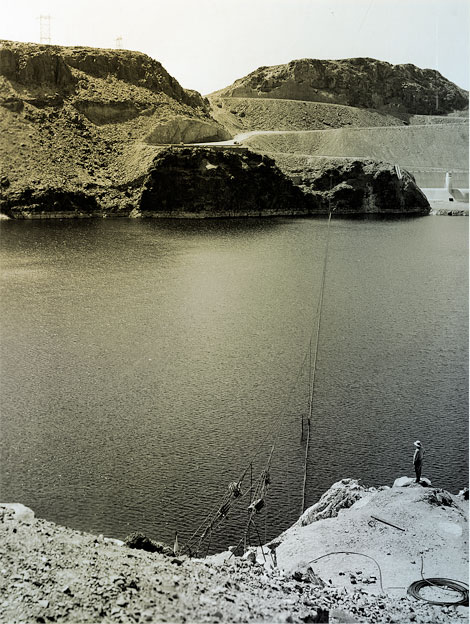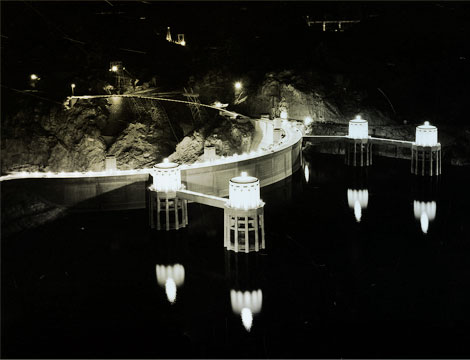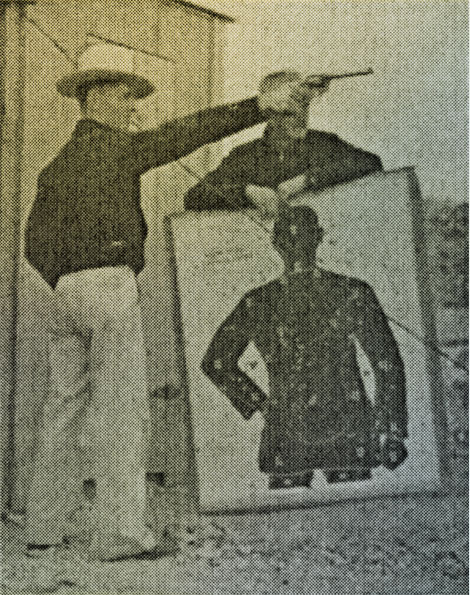

 Cable across Lake Mead and security fencing, May 1940. Reclamation photo.
Cable across Lake Mead and security fencing, May 1940. Reclamation photo.World War II transformed central Arizona and the Phoenix area. Copper mining again thrived because of the need for the metal in the war effort. The Phelps Dodge company needed water for its copper mining operations, and the Salt River Project worked with them to build Horseshoe Dam on the Verde River. The dam would be a benefit to the private company and to Arizona's residents for its water storage capabilities.
The partnership between Reclamation and the states of Arizona and Nevada had an even bigger impact on the war effort through the production of power at Hoover Dam.
PROTECTING HOOVER DAM
Even before the December 7, 1941, attack on Pearl Harbor, which marked the United State's entry into World War II, Washington worried about the safety of America's high-profile, power-generating dams. Tension and intrigue filled the period leading up to World War II.
On the evening of November 30, 1939, the State Department received word from the U.S. embassy in Mexico of an alleged plot to bomb the intake towers at Hoover Dam. The plot by German agents, discovered in Mexico City, hoped to paralyze the aviation manufacturing industry in Los Angeles by cutting off their main source of electricity.
 Hoover Dam with lighted intake towers, December 1940. Reclamation photo.
Hoover Dam with lighted intake towers, December 1940. Reclamation photo.The State Department immediately contacted Reclamation Commissioner John Page and advised that all navigation on Lake Mead, particularly near the dam, should be suspended without delay. The State Department instructed Page to keep all information regarding the plot highly confidential. They did not want the information to reach the public or the press. Reclamation instantly banned all private boats from the Colorado River within Black Canyon where the dam is located. Employees could only enter the dam when they were on duty and with special permission. They could not take anyone else into the dam without specific authorization.
Reclamation increased its ranger force by several men and installed floodlights to illuminate the channel above the intake towers at the dam. The National Park Service, which was responsible for activities on Lake Mead (the reservoir formed by Hoover Dam) increased its patrol activities. A wire net strung from a cable that stretched across the lake prevented boats from getting within three hundred feet of the intake towers. Reclamation and the Park Service took great care to minimize the impact of these extra security measures on visitors.
| The events of September 11, 2011, rekindled fears of an attack on Hoover Dam. Newspaper articles, reminiscent of those published during World War II, raised the specter of possible sabotage and the need for increased security. Once again, safeguarding one of the country's most well-known and recognized landmarks became a matter of national security. |
Two years passed with visitors and tourists hardly aware of these added security measures protecting Hoover Dam from danger. But concern for the comfort of visitors and tourists was soon abandoned.
On September 17, 1941, with international tensions growing more frightening every day, the Secretary of the Interior approved "Regulations Governing the Protection of Structures." These regulations applied to Reclamation projects in operation or under construction. Hoover Dam fell under the definition of a Class I structure, which meant it was "of paramount importance to and irreplaceable in operations of national defense by reason of major power supply." This meant Hoover Dam required the highest level of protection: "adequate and complete protection of all vulnerable features at all times by a sufficient number of armed guards."
Three months later, at 5:30 p.m. on December 7, 1941, when Pearl Harbor was attacked, the dam was closed to the public and all traffic moved over the dam under convoy for the duration of the war.
ON THE ALERT! Guards on Reclamation structures improve their markmanship. Photo from Reclamation ERA, Feb.1942 Guards on Reclamation structures improve their markmanship. Photo from Reclamation ERA, Feb.1942Already in effect when Pearl Harbor was attacked were plans for protecting vitally important Reclamation project structures from sabotage. The attack merely sounded the signal for the alert. At Boulder Dam, a company of Military Police had been patrolling the switchyards and outlying facilities for several months supplementing the augmented force of rangers. Visitors were barred from the dam structures and other extraordinary precautions were taken. Other projects had been patrolled for several months, such as the dams and other structures of the Salt River project, where the Salt River Valley Water Users Association had built up a protective organization. Projects operated by water users are the responsibility of local organizations, under arrangements the Secretary of the Interior is authorized to make with them. Source: Adapted from "The Reclamation Era", February 1942 |
HOOVER DAM'S IMPORTANCE TO THE WAR EFFORT
Construction of Hoover Dam in the 1930s marked the beginning of large-scale, multi-purpose, water resource developments for the Bureau of Reclamation. Power production was an authorized purpose of the dam, but few could have anticipated the surge in demand for power that would be caused by the outbreak of World War II.
With the advent of World War II, the nation's need for hydroelectric power soared. At the outbreak of the war, the Axis Nations (Germany, Italy, and Japan) had three times more available power than the United States. This 1942 statement on "The War Program of the Department of the Interior" identified our demand for power:
"The war budget of $56 billion will require 154 billion kWh of electric energy annually for the manufacture of airplanes, tanks, guns, warships, and fighting material, and to equip and serve the men of the Army, Navy and Marine Corps."
Hydroelectric power provided one of the fastest ways to expand the country's energy output. For example, in 1941, Reclamation produced more than 5 billion kWh, resulting in a 25% increase in aluminum production. By 1944, Reclamation quadrupled its hydroelectric power output in order to support the needs of war.
From 1940 through 1945, Hoover Dam operated its generators full time. Throughout the war, Hoover Dam and other Reclamation powerplants produced 47 billion kWh of electricity, enough to make:
| 69,000 airplanes | 79,000 machine guns |
| 5,000 ships | 7,000,000 aircraft bombs |
| 5,000 tanks | 31,000,000 shells |
BOULDER DAM OR HOOVER DAM?Both the names Hoover and Boulder have been used for the dam. In 1930, Interior Secretary Ray Wilbur announced that the dam would be called Hoover Dam, and Congress affirmed the name to honor the then-President of the United States. After Roosevelt took office in 1933, the dam was frequently called Boulder Dam or Boulder Canyon Dam, allegedly because Roosevelt's Interior Secretary, Harold Ickes, did not like Hoover. The dam was actually built in Black Canyon, but it had originally been authorized under the Boulder Canyon Act. Engineers later decided that Black Canyon would be a better location for the dam, but the project continued to be known as the Boulder Canyon Project. Therefore, documents from 1933 through most of the 40s often refer to the dam as Boulder Dam. In April 1947, an act of Congress signed by President Truman officially confirmed the name as Hoover Dam. |
Sources:
http://www.usbr.gov/power/edu/history.html
http://crm.cr.nps.gov/archive/23-01/23-01-2.pdf
http://www.archives.gov/publications/prologue/2003/summer/hoover-dam-2.html
